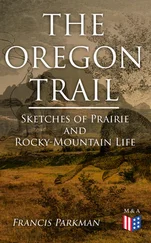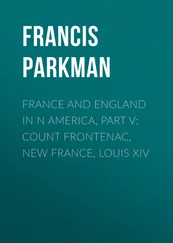Francis Parkman - A Half-Century of Conflict - Volume II
Здесь есть возможность читать онлайн «Francis Parkman - A Half-Century of Conflict - Volume II» — ознакомительный отрывок электронной книги совершенно бесплатно, а после прочтения отрывка купить полную версию. В некоторых случаях можно слушать аудио, скачать через торрент в формате fb2 и присутствует краткое содержание. Жанр: foreign_prose, История, foreign_edu, foreign_antique, на английском языке. Описание произведения, (предисловие) а так же отзывы посетителей доступны на портале библиотеки ЛибКат.
- Название:A Half-Century of Conflict - Volume II
- Автор:
- Жанр:
- Год:неизвестен
- ISBN:нет данных
- Рейтинг книги:4 / 5. Голосов: 1
-
Избранное:Добавить в избранное
- Отзывы:
-
Ваша оценка:
- 80
- 1
- 2
- 3
- 4
- 5
A Half-Century of Conflict - Volume II: краткое содержание, описание и аннотация
Предлагаем к чтению аннотацию, описание, краткое содержание или предисловие (зависит от того, что написал сам автор книги «A Half-Century of Conflict - Volume II»). Если вы не нашли необходимую информацию о книге — напишите в комментариях, мы постараемся отыскать её.
A Half-Century of Conflict - Volume II — читать онлайн ознакомительный отрывок
Ниже представлен текст книги, разбитый по страницам. Система сохранения места последней прочитанной страницы, позволяет с удобством читать онлайн бесплатно книгу «A Half-Century of Conflict - Volume II», без необходимости каждый раз заново искать на чём Вы остановились. Поставьте закладку, и сможете в любой момент перейти на страницу, на которой закончили чтение.
Интервал:
Закладка:
These savages belonged to a group of stationary tribes, only one of which, the Caddoes, survives to our day as a separate community. Their enemies the Chickasaws, Osages, Arkansas, and even the distant Illinois, waged such deadly war against them that, according to La Harpe, the unfortunate Nassonites were in the way of extinction, their numbers having fallen, within ten years, from twenty-five hundred souls to four hundred. [Footnote: Bénard de la Harpe, in Margry, VI. 264.]
La Harpe stopped among them to refresh his men, and build a house of cypress-wood as a beginning of the post he was ordered to establish; then, having heard that a war with Spain had ruined his hopes of trade with New Mexico, he resolved to pursue his explorations.
With him went ten men, white, red, and black, with twenty-two horses bought from the Indians, for his journeyings were henceforth to be by land. The party moved in a northerly and westerly course, by hills, forests, and prairies, passed two branches of the Wichita, and on the 3d of September came to a river which La Harpe calls the southwest branch of the Arkansas, but which, if his observation of latitude is correct, must have been the main stream, not far from the site of Fort Mann. Here he was met by seven Indian chiefs, mounted on excellent horses saddled and bridled after the Spanish manner. They led him to where, along the plateau of the low, treeless hills that bordered the valley, he saw a string of Indian villages, extending for a league and belonging to nine several bands, the names of which can no longer be recognized, and most of which are no doubt extinct. He says that they numbered in all six thousand souls; and their dwellings were high, dome-shaped structures, built of clay mixed with reeds and straw, resting, doubtless, on a frame of bent poles. [Footnote: Beaurain says that each of these bands spoke a language of its own. They had horses in abundance, descended from Spanish stock. Among them appear to have been the Ouacos, or Huecos, and the Wichitas,—two tribes better known as the Pawnee Picts. See Marcy, Exploration of Red River. ] With them were also some of the roving Indians of the plains, with their conical teepees of dressed buffalo-skin.
The arrival of the strangers was a great and amazing event for these savages, few of whom had ever seen a white man. On the day after their arrival the whole multitude gathered to receive them and offer them the calumet, with a profusion of songs and speeches. Then warrior after warrior recounted his exploits and boasted of the scalps he had taken. From eight in the morning till two hours after midnight the din of drums, songs, harangues, and dances continued without relenting, with a prospect of twelve hours more; and La Harpe, in desperation, withdrew to rest himself on a buffalo-robe, begging another Frenchman to take his place. His hosts left him in peace for a while; then the chiefs came to find him, painted his face blue, as a tribute of respect, put a cap of eagle-feathers on his head, and laid numerous gifts at his feet. When at last the ceremony ended, some of the performers were so hoarse from incessant singing that they could hardly speak. [Footnote: Compare the account of La Harpe with that of the Chevalier de Beaurain; both are in Margry, VI. There is an abstract in Journal historique. ]
La Harpe was told by his hosts that the Spanish settlements could be reached by ascending their river; but to do this was at present impossible. He began his backward journey, fell desperately ill of a fever, and nearly died before reaching Natchitoches.
Having recovered, he made an attempt, two years later, to explore the Arkansas in canoes, from its mouth, but accomplished little besides killing a good number of buffalo, bears, deer, and wild turkeys. He was confirmed, however, in the belief that the Comanches and the Spaniards of New Mexico might be reached by this route.
In the year of La Harpe's first exploration, one Du Tisné went up the Missouri to a point six leagues above Grand River, where stood the village of the Missouris. He wished to go farther, but they would not let him. He then returned to the Illinois, whence he set out on horseback with a few followers across what is now the State of Missouri, till he reached the village of the Osages, which stood on a hill high up the river Osage. At first he was well received; but when they found him disposed to push on to a town of their enemies, the Pawnees, forty leagues distant, they angrily refused to let him go. His firmness and hardihood prevailed, and at last they gave him leave. A ride of a few days over rich prairies brought him to the Pawnees, who, coming as he did from the hated Osages, took him for an enemy and threatened to kill him. Twice they raised the tomahawk over his head; but when the intrepid traveller dared them to strike, they began to treat him as a friend. When, however, he told them that he meant to go fifteen days' journey farther, to the Padoucas, or Comanches, their deadly enemies, they fiercely forbade him; and after planting a French flag in their village, he returned as he had come, guiding his way by compass, and reaching the Illinois in November, after extreme hardships. [Footnote: Relation de Bénard de la Harpe. Autre Relation du même. Du Tisné à Bienville. Margry, VI. 309, 310, 313.]
Early in 1721 two hundred mounted Spaniards, followed by a large body of Comanche warriors, came from New Mexico to attack the French at the Illinois, but were met and routed on the Missouri by tribes of that region. [Footnote: Bienville au Conseil de Régence, 20 Juillet, 1721. ] In the next year, Bienville was told that they meant to return, punish those who had defeated them, and establish a post on the river Kansas; whereupon he ordered Boisbriant, commandant at the Illinois, to anticipate them by sending troops to build a French fort at or near the same place. But the West India Company had already sent one Bourgmont on a similar errand, the object being to trade with the Spaniards in time of peace, and stop their incursions in time of war. [Footnote: Instructions au Sieur de Bourgmont, 17 Jan. 1722. Margry, VI. 389.] It was hoped also that, in the interest of trade, peace might be made between the Comanches and the tribes of the Missouri. [Footnote: The French had at this time gained a knowledge of the tribes of the Missouri as far up as the Arickaras, who were not, it seems, many days' journey below the Yellowstone, and who told them of "prodigiously high mountains,"—evidently the Rocky Mountains. Mémoire de la Renaudière , 1723.]
Bourgmont was a man of some education, and well acquainted with these tribes, among whom he had traded for years. In pursuance of his orders he built a fort, which he named Fort Orléans, and which stood on the Missouri not far above the mouth of Grand River. Having thus accomplished one part of his mission, he addressed himself to the other, and prepared to march for the Comanche villages.
Leaving a sufficient garrison at the fort, he sent his ensign, Saint-Ange, with a party of soldiers and Canadians, in wooden canoes, to the villages of the Kansas higher up the stream, and on the 3d of July set out by land to join him, with a hundred and nine Missouri Indians and sixty-eight Osages in his train. A ride of five days brought him again to the banks of the Missouri, opposite a Kansas town. Saint-Ange had not yet arrived, the angry and turbid current, joined to fevers among his men, having retarded his progress. Meanwhile Bourgmont drew from the Kansas a promise that their warriors should go with him to the Comanches. Saint-Ange at last appeared, and at daybreak of the 24th the tents were struck and the pack-horses loaded. At six o'clock the party drew up in battle array on a hill above the Indian town, and then, with drum beating and flag flying, began their march. "A fine prairie country," writes Bourgmont, "with hills and dales and clumps of trees to right and left." Sometimes the landscape quivered under the sultry sun, and sometimes thunder bellowed over their heads, and rain fell in floods on the steaming plains.
Читать дальшеИнтервал:
Закладка:
Похожие книги на «A Half-Century of Conflict - Volume II»
Представляем Вашему вниманию похожие книги на «A Half-Century of Conflict - Volume II» списком для выбора. Мы отобрали схожую по названию и смыслу литературу в надежде предоставить читателям больше вариантов отыскать новые, интересные, ещё непрочитанные произведения.
Обсуждение, отзывы о книге «A Half-Century of Conflict - Volume II» и просто собственные мнения читателей. Оставьте ваши комментарии, напишите, что Вы думаете о произведении, его смысле или главных героях. Укажите что конкретно понравилось, а что нет, и почему Вы так считаете.












